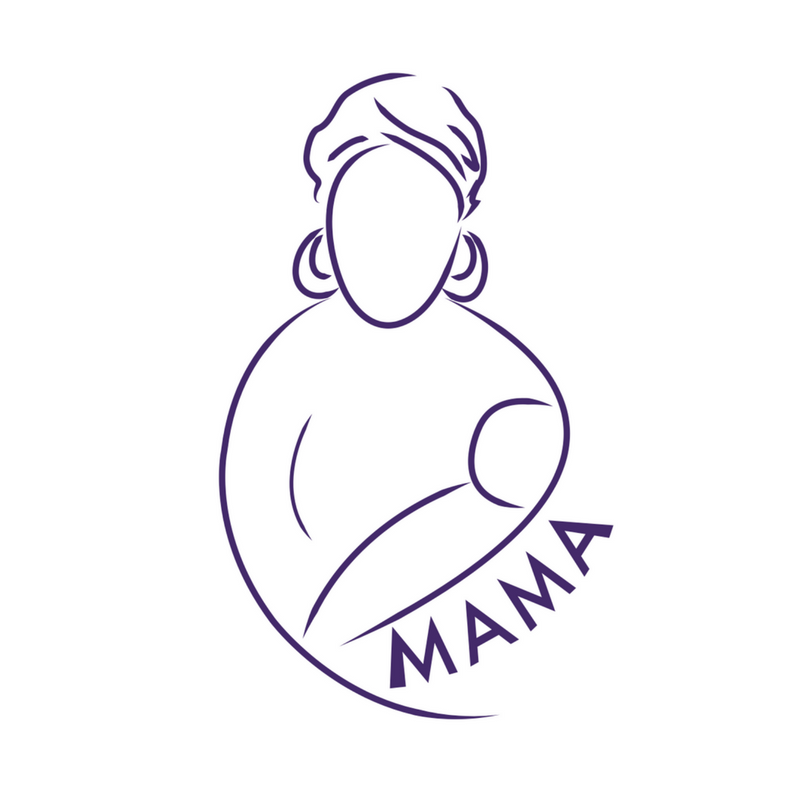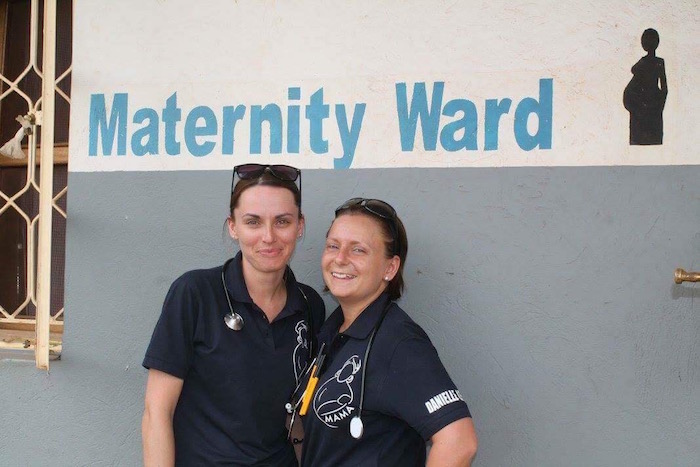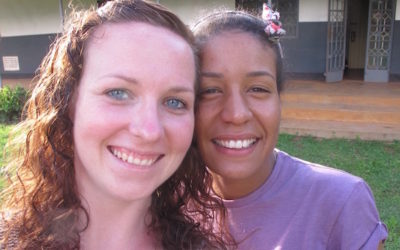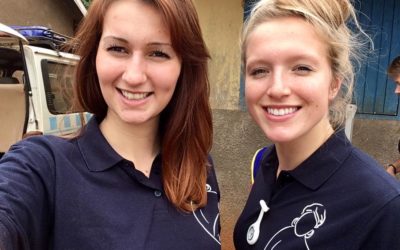Hayley
JUNE – JULY 2016
In June 2016, myself and another third year student midwife were given the opportunity to go to Uganda for our elective placement. At first I was unsure how I would find the whole experience, would I struggle being so far away from my family and loved ones, would I be able to adjust to minimal equipment within the maternity settings, and most importantly how would I cope with the major obstetric emergencies, which are common in Africa.
During our 10 day stay in Uganda, we worked mainly in Azur medical centre, working alongside core maternity staff. The maternity ward itself consisted of 14 beds; antenatal, postnatal and sick mothers. Many of the antenatal women we saw in our stay were early labourers, women suffering from malaria and one snake bite victim. Postnatally we saw women after normal SVD deliveries and post op women recovering after Caesareans sections. In our stay we picked up two cases of neonatal sepsis who were quickly referred to paediatricians for treatment. In the labour ward, there were two maternity beds, divided by a curtain. Women laboured quietly with the help of a birth attendant for support. The Midwives listened to the fetal heart on admission using a pinard, and then allowed the woman to mobilise and await labour. I found this such a different experience from the UK where we would listen to the fetal heart every 15 minutes in the first stage and then every 5 minutes in the second stage, we would fill in a partogram and document every single event; however in Africa documentation was minimal.
During our stay we also visited Hoima Referral hospital, a government hospital. Its service area comprises of Hoima, Masindi, Bulisa, and Kibaale with an approximation of 1,000,000 people. The labour ward consisted of six rooms with two delivery beds within each room. Women laboured next to each other quietly. When we went into the labour ward, we came across a woman who appeared to be in the second stage of labour. No midwife was looking after her so myself and the rest of the UK mama team assessed her and realised she was 27-28 weeks, fully dilated and very shortly afterwards an SVD of a male infant was delivered. The baby was taken to the neonatal team for oxygen support, and upon leaving appeared to be doing well. The second women we looked after was a woman having a c/s for shoulder presentation and ?transverse lie. The baby was delivered under general anaesthetic and the baby came out in poor condition – floppy, blue, covered in thick meconium, and needed neonatal resuitation, however luckily recovered well.
While on our 10 day visit we were able to visit Runga, a little fishing village, not to take part in the outreach clinics, but so that Rhi and the African MAMA team, could discuss the possibility of an Azur midwife being able to stay in the village, allowing 24/7 midwifery support to expecting mothers in the village. The midwife could offer antenatal services, screening, immunisation, family planning and support women in labour. The village leaders were very pleased to welcome this opportunity in the village and accommodation and maternity rooms have been secured to commence in January 2017.
Unfortunately our 10 days in Uganda came to an end, and I can truly say it has been the best experience , both personally and professionally. It has opened my eyes to how the other side live and made me realise how much we take for granted here in the UK. This is an experience I will cherish forever and I hope I can come back next year to join the MAMA team.
Danielle
JUNE – JULY 2016
When I was in my first year of training as a midwife, I found out that Rhi, one of the midwives I worked with was part of MAMA. I knew straight away that visiting Uganda was definitely what I wanted to do for my elective in my final year. I knew that it would be a great opportunity to see how midwifery is practiced in another country, especially one that still has a high maternal and neonatal mortality rate. Having 2 young children and also trying to match up time when I was available from university and when MAMA was visiting Uganda, I wasn’t 100% sure a trip would definitely pan out. Luckily for me, everything seemed to fit into place and my trip was booked!
I booked with my friend, Danielle from my cohort. We were flying out to join Rhi and Lucy, a first year medical student who had been a few times before. I was very excited to be going to Uganda, but was a little apprehensive as I had never left my children before for a long period, but knew deep down everything would be ok.
We arrived in Uganda and I was even more excited now we were actually there and looked forward to getting to Hoima to start work. We got to visit Runga, one of the outreach clinics. Rhi was meeting with the village leaders about having an Azur midwife stay with them, therefore enabling them to have access to a wide range of services 24/7. Although we didn’t get to do a clinic there, it was really helpful to visit Runga so we could get a perspective of what it is like and what journey the women have to do if they are referred to Azur clinic. The day was a success all round, as Rhi got permission for an Azur midwife to stay and rooms for clinic, delivery and staff accommodation.
We spent most of our time at Azur clinic as that is where MAMA is based, but did also get the opportunity to visit Hoima regional referral hospital which is the government hospital. Although the midwives in Uganda have a lot of autonomy, women are left on their own quite a lot, even in labour. I feel this is partly due to culture, as every woman has a birth attendant with them, who attends to all their needs, but also the midwives are extremely stretched with such a vast population.
The women in Uganda are very strong and don’t make a fuss throughout labour, even though they have no pain relief! They are pretty much silent throughout, tapping their leg when they get a contraction and are very mobile up until delivery, when they will get on the bed to deliver. They walk straight back to the ward and if the delivery is normal, they are usually discharged pretty quickly too, again walking back home, wherever that may be!
At home observations are a big part of our day and in Uganda it made me realise how important they are, in one day on the post op bay, there were 3 women and I picked up 2 babies with sepsis; this seemed to be the norm! It’s just trying to ensure the midwives realise the importance of observations and even if they can just get one set done a day or before the women are discharged can make such a difference. We saw a wide range of issues varying from premature labour, malaria, a snake bite, unstable lie which needed a section and then a very flat baby. Luckily all had good outcomes.
I was expecting to see quite a few obstetric emergencies, especially as they have a high rate of postpartum haemorrhage, but we didn’t have any, which was good for the women, although we did have to resuscitate a very flat baby at Hoima referral hospital, but luckily it responded very well and was taken to the new neonatal unit for antibiotics as there was thick meconium.
My time in Uganda went far too quick and although I worried about leaving my children, I think I could have managed going for a longer period, as although you miss home, you’re busy with work and the days just fly by! I feel this trip has been a big eye opener and has enhanced my learning and just want to say a big thank you to MAMA and especially Rhi for such an amazing experience. I would definitely love to go back to Uganda and hope this is something I can do again in the future as a qualified midwife.
Liz Payne
“We went into the kangaroo care ward, it was like a ray of sunshine: skin-to-skin care is the most effective way of regulating a baby’s heart rate and temperature, as well as helping to initiate breastfeeding and bonding and they were promoting this form of care. With many premature babies being born this was essential to their survival, and it was happening….”
Sara & Laura
“We were able to observe finely-tuned, fundamental, midwifery skills being practiced at their best – which, dare I say it, may on occasion be overlooked when technology is readily available. That being said, under-resourcing of essential supplies is a massive issue, which, whilst it may arguably lead to well-honed midwifery skills, is a huge challenge to overcome. Even the most skilled midwife has the odds stacked against them when the region has no O negative blood.”
Stacey
“I was in my final year of midwifery training and I grabbed the opportunity with both hands to go to Uganda… The thing I loved the most was we weren’t there as a team to take over the role of the local midwives, we were there to work together, support them and learn from each other.”




